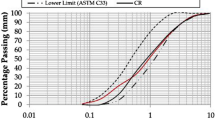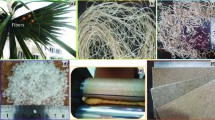Abstract
This paper is in the following of our previous study about modeling of bone china optical properties as functions of feed composition. In the present study, the effect of feed composition on bone china physical characteristics such as bulk density, thermal expansion coefficient (TEC), and firing shrinkage by using response surface methodology (RSM) and MATLAB software was investigated. In this regard, based on batch calculation diagram, 13 feed compositions around commercial composition of bone china were chosen and investigated according to RSM methodology. Second-order polynomial equations were used to simulate these properties and RSM model validations showed the accuracy of the estimated models. Also, the similarity between surface plot areas and real changes during firing cycle showed that the models are trustable to predict these physical features.



Similar content being viewed by others
References
Zakaria, Z., Haron, H.: Characterisation of local bone ash for bone China production. Jurnal Teknologi. 661(1), 25–34 (2013)
Farhadian, N., Shariati-Niassar, M.: Calculation of physical properties of the methanol-water mixture using molecular dynamics simulation. Iran J chem engine. 6(4), 62–72 (2009)
Klopman, G., McGonigal, M.: Computer simulation of physical-chemical properties of organic molecules. 1. Molecular system identification. J Chem Inf Comput Sci. 21(1), 48–52 (1981)
Brand, H.E., Fortes, A.D., Wood, L.G., Knight, K.S., Vocadlo, L.: The thermal expansion and crystal structure of mirabilite (Na2SO410D2O) from 4.2 to 300 K determined by time-of-flight neutron powder diffraction. Phys Chem Minerals. –269. doi:10.1007/s00269-008-0256-0
Lind, C.: Two decades of negative thermal expansion research: where do we stand? Materials. 5(6), 1125–1154 (2012)
Chen, X., Zhou, G.D., Kiswandhi, A., Miotkowski, I., Chen, Y.P.: Thermal expansion coefficients of Bi2Se3 and Sb2Te3 crystals from 10 K to 270 K. Appl Phys Lett. 99, 20–27 (2011)
Bezerra, M., Santelli, R., Oliveira, E., Villar, L., Escaleira, L.: Response surface methodology (RSM) as a tool for optimization in analytical chemistry. Talanta. 76, 965–977 (2008)
Olayiwola, O.M., Amahia, G.N., Adewara, A.A., Chukwu, U.: Application of response surface methodology for capturing optimum response in a longitudinal survey. Int J App Sci Tech. 1, 171–176 (2011)
Ahsan, M., Dewan, A.H., Mustafi, S., Ahmedc, S.: Characterization of crystalline phases of bone ash, Bangladesh. J Sci Ind Res. 47(3), 265–268 (2012)
Yates, B.: Thermal expansion, pp. 33–36. Plenum Press, New York – London (1972)
Konijnendijk, W.B., Stevels, J.M.: The linear expansion of borosilicate glasses in relation to their structure. Verres Réfract. 30(3), 371–378 (1976)
Morey, G.W.: The properties of glass Reinhold, pp. 264–270. Publishing Corp, New York (1938)
English, S., Turner, W.E.S.: The heat expansion of soda-lime glasses. J Soc Glas Technol. 3, 238–250 (1919)
Acknowledgments
We are grateful to Sargol Bone China Production Co. for the financial assistance and Mrs. Zahra Hejazi for his contributions to testing.
Author information
Authors and Affiliations
Corresponding author
Additional information
Available online at: http://www.austceram.com/category/journal/
Rights and permissions
About this article
Cite this article
Arasteh Nodeh, A., Broomandi Barati, S. Using response surface methodology to investigate bone china characteristics: (II) physical characteristics. J Aust Ceram Soc 53, 143–147 (2017). https://doi.org/10.1007/s41779-016-0018-2
Received:
Revised:
Accepted:
Published:
Issue Date:
DOI: https://doi.org/10.1007/s41779-016-0018-2




